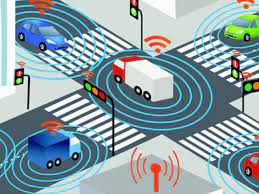Car with V2V communication feature
Vehicle-to-vehicle (V2V) communication enables vehicles to wirelessly exchange information about their speed,
location, and heading. The technology behind V2V communication allows vehicles to broadcast and receive
omni-directional messages (up to 10 times per second), creating a 360-degree “awareness” of other vehicles in
proximity. Vehicles equipped with appropriate software (or safety applications) can use the messages from
surrounding vehicles to determine potential crash threats as they develop. The technology can then employ visual,
tactile, and audible alerts—or, a combination of these alerts—to warn drivers. These alerts allow drivers the
ability to take action to avoid crashes.
These V2V communication messages have a range of more than 300 meters and can detect dangers obscured by traffic,
terrain, or weather. V2V communication extends and enhances currently available crash avoidance systems that use
radars and cameras to detect collision threats. This new technology doesn’t just help drivers survive a crash—it
helps them avoid the crash altogether.
Vehicles that could use V2V communication technology range from cars and trucks to buses and motorcycles. Even
bicycles and pedestrians may one day leverage V2V communication technology to enhance their visibility to motorists.
Additionally, vehicle information communicated does not identify the driver or vehicle, and technical controls are
available to deter vehicle tracking and tampering with the system.
V2V communication technology can increase the performance of vehicle safety systems and help save lives. There were
an estimated 6.8 million police-reported crashes in 2019, resulting in 36,096 fatalities and an estimated 2.7
million people injured. Connected vehicle technologies will provide drivers with the tools they need to anticipate
potential crashes and significantly reduce the number of lives lost each year.

Vehicle-to-vehicle (V2V) communication enables vehicles to wirelessly exchange information about their speed,
location, and heading. The technology behind V2V communication allows vehicles to broadcast and receive
omni-directional messages (up to 10 times per second), creating a 360-degree “awareness” of other vehicles in
proximity. Vehicles equipped with appropriate software (or safety applications) can use the messages from
surrounding vehicles to determine potential crash threats as they develop. The technology can then employ visual,
tactile, and audible alerts—or, a combination of these alerts—to warn drivers. These alerts allow drivers the
ability to take action to avoid crashes.
These V2V communication messages have a range of more than 300 meters and can detect dangers obscured by traffic,
terrain, or weather. V2V communication extends and enhances currently available crash avoidance systems that use
radars and cameras to detect collision threats. This new technology doesn’t just help drivers survive a crash—it
helps them avoid the crash altogether.
Vehicles that could use V2V communication technology range from cars and trucks to buses and motorcycles. Even
bicycles and pedestrians may one day leverage V2V communication technology to enhance their visibility to motorists.
Additionally, vehicle information communicated does not identify the driver or vehicle, and technical controls are
available to deter vehicle tracking and tampering with the system.
V2V communication technology can increase the performance of vehicle safety systems and help save lives. There were
an estimated 6.8 million police-reported crashes in 2019, resulting in 36,096 fatalities and an estimated 2.7
million people injured. Connected vehicle technologies will provide drivers with the tools they need to anticipate
potential crashes and significantly reduce the number of lives lost each year.